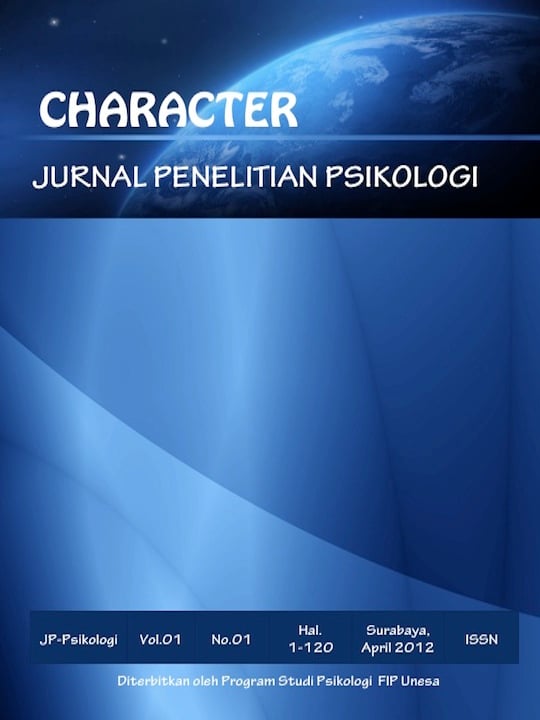Surface acting dan deep acting ditinjau dari Resilience Pada Perawat Ruang Rawat Inap Umum
DOI:
https://doi.org/10.26740/cjpp.v9i1.45845Abstract
Abstrak
Pada masa Pandemic COVID-19 ini diketahui bahwa peningkatan jumlah pasien yang ada dirumah sakit menimbulkan munculnya problem seperti kelelahan pada perawat, stress dan ketidakpuasan kerja yang diakibatkkan oleh beban kerja yang meningkat. Problem ini muncul dikarenakan kurang pemahanmannya dan ketahanan perawat dalam melakukan pengaturan emosi melalui ekspresi dan perasaan. Penelitian ini bertujuan untuk mengetahui relevansi antara resiliensi dengan surface acting dan deep acting pada perawat pada masa pandemic COVID-19. Penelitian ini menggunakan metode kuantitatif dengan jumlah populasi sebanyak 125. Penelitian ini menggunakan total sampling yang didefinisikan sebagai jumlah dari populasi keseluruan akan digunakan sebagai subjek penelitian. Intrumen yang digunakan pada skala resilience disusun berdasarkan aspek dari Maddi (2013)., berjumlah 32 aitem. Sedangkan apda skala surface acting dan deep acting disusun berdasarkan aspek dari Robbins & Judge (2019) berjumlah 29 aitem. Untuk analisis yang digunakan pada penelitian ini adalah korelasi pearson product moment yang digunakan sebagai uji statistik kedua variabel dengan maksud untuk mengetahui hubungan antara surface acting dengan resilience dan deep acting dengan resilience. Hasil dari uji statistik product moment menunjukkan korelasi signifikansi sebesar 0,003 (0,05). Hasil dari uji statistik product moment diketahui bahwa surface acting memiliki hubungan dengan risilience pada diri perawat, sedangkan pada deep acting juga memiliki keterkaitan dengan risilience pada diri perawat. Hal ini berarti bahwa perawat dengan tingkat ketahanan psikologis yang baik akan mampu melakukan kontrol yang baik pada dirinya, terkait dengan tekanan yang dimunculkan pada tempat kerja melakui tuntutan emosi dan ekspresi saat melakukan pekerjaannya.
Kata Kunci: Surface acting, deep acting, Ketahanan Psikologi, Perawat
Abstract
During the COVID-19 pandemic, it was known that the increase in the number of patients in hospitals caused problems such as fatigue for nurses, stress and job dissatisfaction caused by an increased workload. This problem arises due to the lack of understanding and resilience of nurses in managing emotions through expressions and feelings. This study aims to determine the relevance of resilience with surface acting and deep acting on nurses during the COVID-19 pandemic. This study uses a quantitative method with a total population of 125. This study uses a total sampling which is defined as the number of the entire population will be used as research subjects. The instruments used on the resilience scale are arranged based on aspects from Maddi (2013), totaling 32 items. Meanwhile, the surface acting and deep acting scales are arranged based on the aspects of Robbins & Judge (2019) totaling 29 items. The analysis used in this research is the Pearson product moment correlation which is used as a statistical test for the two variables with the aim of knowing the relationship between surface acting and resilience and deep acting and resilience. The results of the product moment statistical test showed a significant correlation of 0.003 (0.05). The results of the product moment statistical test show that surface acting has a relationship with nurses' self-resilience, while deep acting also has a relationship with nurses' self-resilience. This means that nurses with a good level of psychological resilience will be able to exercise good control over themselves, related to the pressure that arises in the workplace through emotional demands and expressions when doing their work.
Keywords: Surface acting, deep acting, Resilience, Perawat
Downloads
Published
How to Cite
Issue
Section
License
Authors who publish in this journal agree to the following terms:
Copyright in any article is held by the author.
The author grants the journal, publication rights with the work simultaneously licensed under a Creative Commons Attribution License that allows others to share the work with an acknowledgment of the work's authorship and initial publication in this journal.
Authors may enter into separate, additional contractual arrangements for the non-exclusive distribution of the journal's published version of the work (e.g., posting it to an institutional repository or publishing it in a book), with an acknowledgment of its initial publication in this journal.
Authors are permitted and encouraged to post their work online (e.g., in an institutional repository or on their website) prior to and during the submission process, as this can lead to productive exchanges, as well as earlier and greater citation of published work.
 Abstract views: 245
Abstract views: 245





